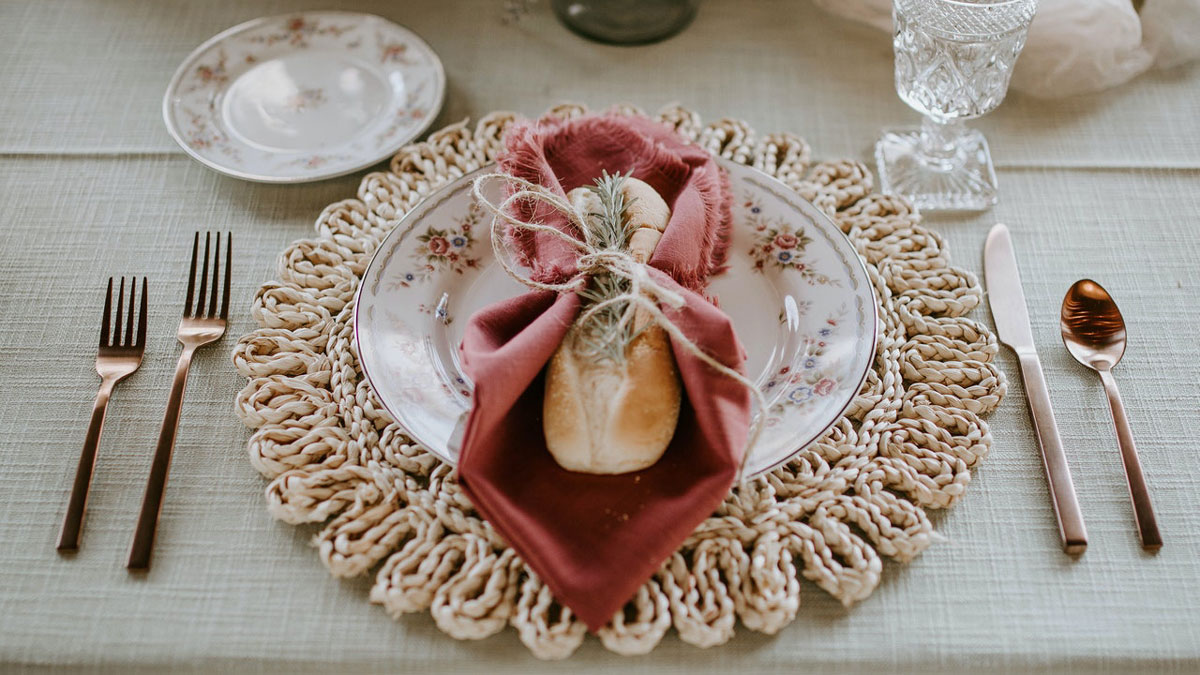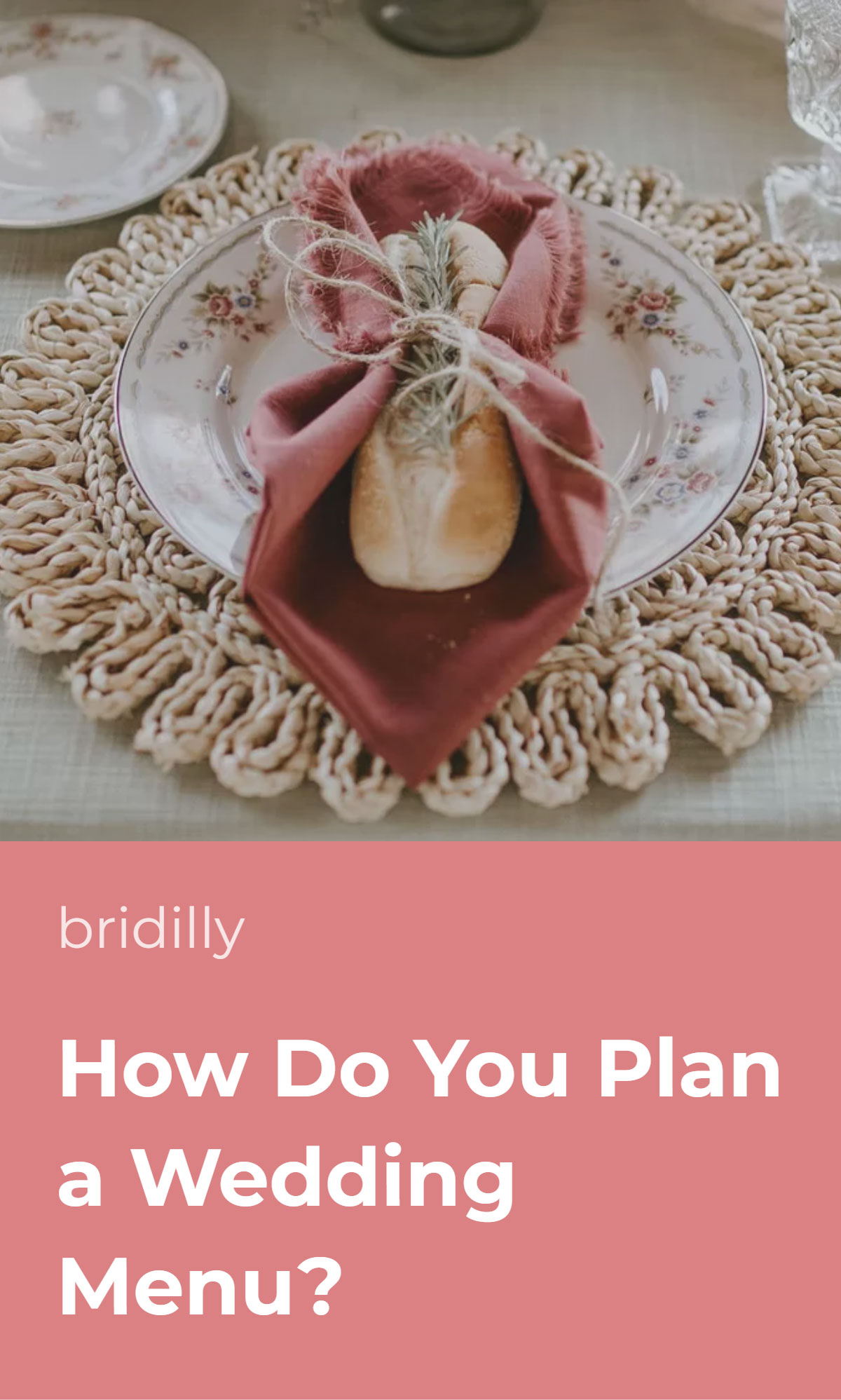Wedding menu planning is an exciting yet stressful process.
It isn’t uncommon for couples to not even know where to start. And an overwhelming selection of options offered by caterers doesn’t help it.
First, you should decide on the basics, such as your budget and wedding reception type. These factors are extremely helpful in decision-making.
Another point to consider is whether you want to order professional catering or make the dinner yourself. The budget typically dictates that, but some brides are excellent cooks who enjoy the process.
Weddings are demanding to the aesthetics. Thus, your wedding menu should match the event theme and be tastefully presented.
In addition, your guests will have certain expectations from the dinner based on the venue, event size, and dress code.
Talking about guests – don’t forget that you’re serving dinner for them in the first place. Some brides can’t eat during the reception due to nervousness, but guests will certainly enjoy the food.
You should consider the food allergies, moral principles, and taste preferences of those attending your wedding.
Finally, don’t neglect beverages. They make a significant part of the menu budget, entertain guests while they’re waiting for food, and support the fun.
Some wedding receptions even put the focus on fancy beverages rather than on food.
Table of Contents [show]
Set Your Budget
Setting your budget should be the top priority when planning a wedding menu.
For example, the average wedding catering price for 66 guests exceeds $4,000, or $62 per plate. That’s one of the most expensive wedding features, along with the venue and rings.
Your budget should be the starting point in determining which type of reception and which meals to choose.
Of course, if you don’t care about money, you can go for the most exquisite plated wedding dinner. But typically, couples have a limit on the menu they can afford.
It’s important to remember about your budget and stand your ground. The issue is, many wedding caterers will try to convince you to order the most expensive options from their selection.
And influencing a bride’s opinion is relatively simple. In addition, pre-wedding nervousness often makes brides emotionally vulnerable.
A pre-defined budget will ensure that you don’t start a new chapter in your life from debt. It also guarantees that all guests will have enough food.
It’s best to opt for a more affordable option in adequate quantities than to offer a scarce amount of luxurious food.
Reception Type
Before you move on to dreaming about the fancy dishes you’ll offer your guests, you should decide on the reception type.
The most popular wedding reception types are plated, buffet, family-style, food stations, and cocktail reception.
A plated dinner is the most formal wedding reception type and thus is favored by many couples. Guests don’t handle the serving themselves and can only choose food from a limited menu.
Such a dinner is also the most expensive of all types, as it involves waiter labor expenses, and the food is usually sophisticated.
A buffet-style wedding reception is a great, contemporary alternative to a formal dinner. However, some guests may consider it overly laid-back.
Still, a buffet reception has numerous advantages, the main being a lower cost and freedom of food choice.
A family-style dinner is a blend of plated and buffet receptions. Food is served on large plates that are passed around the table. This option is best suitable for small weddings.
Food stations are similar to a buffet. But while a buffet offers all foods on the same table, food stations are dedicated to a specific kind of food.
For instance, you may have a cheese station, seafood station, or dessert station.
Lastly, a cocktail reception is the most relaxed option. Guests sip cocktails (obviously) and eat appetizers that are either carried around by waiters or served on a common table.
Catering or DIY
Wedding catering is expensive, that’s no secret. But the price is justified, especially when it comes to large weddings.
Professional catering lets you relax and not spend time cooking, delivering, and serving food. Experienced caterers guarantee your wedding dinner will be flawless.
Perhaps, the cost is the only issue with wedding catering. If your budget is limited, you may try to opt for a DIY wedding dinner. However, in this case, you should consider specific points.
Will you have time to make dinner for 100 guests? Are your cooking skills good enough? Won’t DIY catering add too much stress? Can you ask someone to help?
Planning is crucial in a self-cater wedding. If you neglect it, you may end up paying even more than for professional services.
That’s because professional caterers often buy ingredients in bulk or specialized stores and know how to calculate the required food amount correctly.
Consider Wedding Theme
Food plays a significant role in creating the atmosphere of your wedding. Therefore, your menu should match the event theme.
Let’s assume your wedding follows a glamour theme. Mashed potatoes and homemade roasted chicken may be delicious, but these dishes don’t match the event’s vibe.
On the other hand, scallops and oysters would seem odd at a country-style wedding.
Furthermore, all courses should tie well together. For example, don’t serve bacon in appetizers and seafood in the main course unless you offer various options. Try to stick with food from matching ingredients.
Think About Your Guests
Before deciding on the desired foods, go through your guest list and consider whether anyone has allergies or particular food preferences. You don’t want to leave anyone hungry on your special day.
Even if you’re a huge meat lover, it’s best to offer some vegetarian options. You may also give guests a choice between poultry, meat, and fish.
Even if you host a plated reception, a menu containing different options will be appreciated.
Asking everyone about their allergies is a cumbersome but beneficial process. This way, you show your guests that their comfort matters to you. It also helps to avoid food waste.
Arrange a Tasting
Food tasting is the most fun part of wedding menu planning. Descriptions of meals offered by caterers always sound sophisticated and delicious. But will you like them in practice?
A tasting isn’t mandatory. But it can help you choose the right caterer if you arrange the tasting before signing the contract. Alternatively, you can select the caterer first and use tasting solely to finalize the meal choice.
Tastings vary depending on the caterer. It may be a personalized experience where the caterer recreates the entire menu and discusses options with you in detail.
But it may also be a ballroom with a big buffet crowded with other couples.
A tasting also helps you to look at how food is served in person. If you care about nice wedding pictures, this may be useful.
Don’t Forget About Beverages
Couples often concentrate on food and neglect beverages. However, drinks are an essential part of your menu. This especially relates to alcoholic beverages, as they’re meant to keep your guests entertained.
The beverages should match your chosen dishes. For instance, if you serve seafood, opt for white wine. For beef, choose red varieties.
Beer is an excellent choice for informal weddings, whereas a cocktail reception implies a selection of intricate drinks.
Alcohol makes a large part of the wedding menu budget. And not only the type of drinks affects the cost. You may go for an open bar, paid bar, or simply put some beer and wine on the tables.
An open bar is the most expensive option, especially if you hire a professional bartender who makes signature cocktails.
But if your budget is limited, no one forces you to offer any type of alcohol your guests desire. As long as you offer them something free to drink, your guests can’t complain.
A paid bar can save you a large sum. But if you make all the alcohol paid, your guests may consider it rude.
If you can’t afford a paid bar but don’t want to limit the choice, it’s best to combine a paid bar with a free beverage buffet.
It would be best if you didn’t forget about non-alcoholic beverages either. Some of your guests may drive, be too young, or have another worthy reason not to drink alcohol.
Of course, everyone can drink water, but making it the only non-alcoholic option is a bit boring and inconsiderate.
Food Presentation
Wedding is demanding to the visual appeal of your menu. A beautifully presented dinner will ensure you nice pictures and compliments from the guests.
When choosing your wedding caterer, ask them to show examples of food decoration. For example, some caterers offer full table design, while others may not even provide utensils.
It’s great if the caterer can tailor the food presentation to your wedding theme.
The way dishes are served also is a part of the presentation. Therefore, the waiters should be dressed accordingly to the occasion and follow etiquette best practices.
Season
Season affects not only your choice of attire and venue but also the menu. Two menus of the same style but created for different seasons may differ drastically.
For instance, seafood dinner for summer may involve more raw fish and fresh salads, while for winter, cooked, warm meals and heavier garnish options.
The season may also affect certain ingredient availability. Sure, most ingredients nowadays can be purchased at any time, but their quality will still vary.













No Comments Add one
Leave a Comment